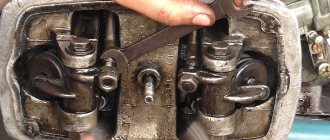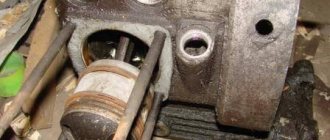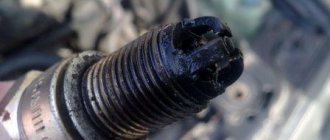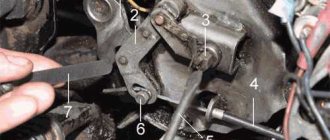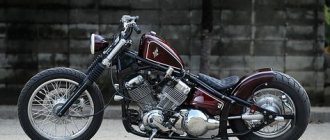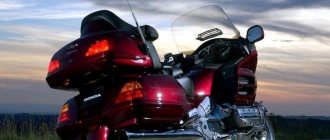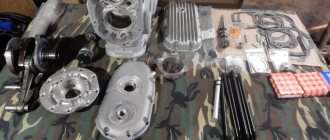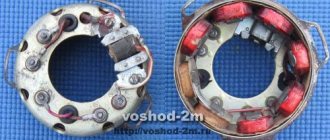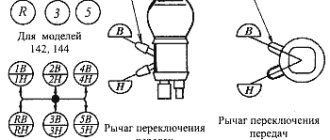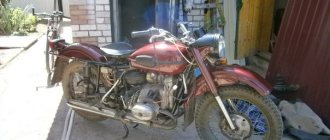What carburetors should be installed in the Urals?
I have a Ural with a 750cc engine. The question arose: Which carburetors should be installed in the Urals? Is it worth installing KAIKHEN or other fancy carburetors? Will this be of any use?
It will be, but provided that you have extra $
The rating is approximately like this:
1. Keikhen 2. Mikuni, etc. with constant discharge 3. Bingi and Ikov 4. K-68 5. K-65
You should strive for constant discharge - the dynamics will significantly improve, etc. In general, read something like
1 There is no difference between Keihen and Mikuni in terms of quality. 1.1 If you install them, then adjustments “by ear and eye” will no longer be enough, otherwise they will work no better than all those listed below. There is no need to put 2 Ikov on 750! Diffuser too small. 3 Put k68, find a normal person (with hands) who will rebuild them and that’s it.
Just don't put k-68.
There are very few pretzels with normal hands, and they themselves are shitty carbs.
Read what you write and what advice you give. First you offer imports, and then immediately the worst of the domestic ones. And the carbs are rotten because they weren’t invented with brains and weren’t made with hands. (he excused himself.)
If you install bourgeois ones, you will have to select jets. otherwise there is no point. They were designed for other engines.
And I personally have had 68s for a long time. 5k away. So far so good.. maybe it’s a MARRIAGE)))))
for APEX
: What kind of device do you have?
Chemical industry, why not drive to 68! If moonshine’s hands don’t grow from there! I drilled holes in them and got everything working properly! I also have inertial supercharging, which also improves the quality of the engine! So you just need to not be lazy and rebuild. And drill holes.
How long can we say that 68 are completely different! I had a set (no need to push my hands) that several fairly experienced motorcycle mechanics tried to adjust! If I can give someone something I want! Especially those who are lucky with carbs and run into the wrong hands!
I put 65 since then and in x. I'm not blowing!
Ikov tried it! Atstoy. As for Mikuni and Keihin, I haven’t tried it! But I really liked the Belarusian K2401 at work! True, who the hell knows how they will survive on a 750 cc machine! They say they produce K2801 type for large-displacement engines. It makes sense to try! The carbs are made head-to-head and not taken from the worst ones! That is, with “Pacco”
for Kudesnik
: where did you drill the holes? Can you be more specific. otherwise they hesitated. It’s impossible to rebuild the boost with K68. (or maybe the driver of the hand.sys is not working well) last season the engine was brainwashed... the supercharged K65 works great on the second motorcycle. but they don’t want k68
We'll say goodbye to the Keihin soon. The plant switches to Italian components. The carbs will probably be Dell Orto. And with constant rarefaction - a thrill. Motz stands on the goat with a lever fork. True, if unadapted carbs from the Japanese are a funnel in the tank.
There is no need to drill anything. They had very bad first games, but then they improved. LKZ himself admits this. The main thing is not to buy a new carb from old stocks.
And the first batches were really drilled in order to achieve at least something from them.
Tut byla musl o inerzionnom nadduve, che-to ne ochen veritsa v ego effectivnost, pomoimu nadduv nachinaet effectivnuyu rabotu tolko after 150 km/h .
2 him_prom_death don't bother running into 68 - the best carbs are from the scoop. and you don't need to drill anything into them. Crap! one idiot wrote in motorcycles - half the country is drilling holes. they need to be set up and driven. and so, naturally, with constant discharge it will be better.
for manowar
: Let's say not the best, but the most affordable. Instead of looking for a normal power supply system, you all prove to me that K-68 is Forever. Even without constant discharge. you can find a good carb. (the same RASSO: K-2401: worse than jikov and even worse than K-65) BUT NOT LIKE K-68
for manowar
: You’re from Moscow, so you should know the store on Aviamotornaya. Go there and consult with Khorok about this, and you’ll see the prices for one thing. (say it’s from Him.)
People, Voyage checkpoint is urgently needed. Send suggestions to [email protected] (thanks in advance.)
for biker980
: This is not the boost you thought about. This is probably a synchronizer. On the contrary, it only works on the lower levels.
Thank you all so much for your advice. See you
Mikuni for each boiler, and go ahead to conquer the peaks of Everest. /may overflow a little/
Mikuni are worth big bucks, however! Six times more expensive than the K-68, which, by the way, I spent the season with without any problems.
Indeed, the quality of carbs depends only on which heel of the worker Ivanov at Lenkarz was bitten by a fruit fly and how much he drank yesterday. I do not argue. But the holes are still not superfluous. because if they are provided for by the design, and some smart guy decided not to drill them, “because it’s cooler,” then this does not mean that in fact, they exist. With the needles raised as high as possible, my candles still remained white. And he didn’t drive at all. Drilled it - everything is ok! you just need to be careful.
Pochem seychas mikuni v Moscow?
for him_prom_death
: I think that everyone knows me there anyway. and now about the carbs: the 68 is not such crap as you, sir, put it. Of the available, widespread ones, it’s the most. If there are other opinions, I’ll give you a pair of any 68, I’ll put it on my rat, I’ll rebuild it and then we’ll check yours. if not a constant discharge, then I think after the adjustment I will have a better result. I don’t recommend changing 68 carburetors, much less drilling them out. those who hate 68 in favor of 65 and older ones simply do not know how to configure them. that's all. What are we talking about here? For those who have 65, I don’t encourage changing them to 68; 68, in my opinion, only has more stable long-term tuning parameters and idle speed. and I sympathize with those pretzels who exchange 68 for older ones.
for biker980
: You can really get a pair for 100. Naturally used and unknown in what condition
for biker980
: You can really get a pair for 100. Naturally used and unknown in what condition
I'll report shortly. I installed Yikovs from Java638 on the Volk (before that I drove a K-68) There was clearly no deterioration or improvement in driving performance - I did not find it. Nevertheless, there are certain advantages - the launch is much better. It spins better (in terms of rpm). The failure is smaller (well, this is completely subjective, it may seem) As for fuel consumption, I have not yet measured it. But I repeat - the bike rides exactly the same as with the K-68. THAT'S SO FUCK.
what were you waiting for? with ordinary carbs, everything will be more or less averagely lousy. Expect a significant improvement in performance only when you install a constant discharge. and even then, you will have to select jets.
About 68 I can confirm that it depends. Either from the phases of the moon, or from some other cycles. We already have a whole collection of them. Some are no good, others (although very similar) are fine. PHENOMENON, dammit.
By the way, everyone here says that you need to configure something special, but what exactly are the features, if not a secret?
A skoka v isvestnom i horoshem sostoianii nado otvalit $$$ ?
So here's the rub:
1. Let's assume K68 is a sane carb
2. K2801 full rulez incl. by price
Question: for some reason he doesn’t drive enough on p2. People gravitate towards p1.
Main question. In the 650 engine with the new type of heads, the carb mounts are at an angle. I haven't tried it yet, but I suspect it will affect their performance. Who is more stable p1 or p2. (XX, acceleration, consumption, etc.)
for Devol
: all because p1 satisfies the people (not in the sense of 100%, just satisfactory carbs, C plus or minus four). Yes, even 2801 will be better, but you need to buy it, install it, configure it and get a slight improvement.
>>But I really liked the Belarusian K2401.
K-68: COMPLETE FAILURE
What kind of carburetors are installed on Urals? The wealth of choice comes down to almost one thing: in most cases these are K63-K65 - devices, in principle, the same in design and properties. Probably, no one except their developers understood why they were assigned different indices... You can also find the unforgettable K301 on old motorcycles, which have a whole bunch of shortcomings. Nevertheless, they turned out to be very tenacious, and therefore have survived in large numbers to this day. Few people remember about more ancient carburetors, like the K36.
Well, okay, the rich you are, the happier you are. This was the case until a few years ago when rumors spread among oppositionists about a new carburetor with a round (unheard of) throttle and unusually progressive characteristics. His name is K68. Let this belong to a forgotten era, but since since then nothing new has been invented in St. Petersburg, the city where it is produced, then, perhaps, it makes sense to talk about this aged “new product” from the height of acquired experience.
Anton Tkachenko, a specialist in motorcycles with boxer engines, tells the story.
“Sixty-eights,” when they went on sale, cost one and a half times more than the K65. But I immediately bought myself a set of new carburetors. You know, I love that all the components on my Ural remain the best. And after reading the advertisements, I had no doubt that the K68 is the best domestic carburetor.
I bought and immediately sent the still fairly fresh K63 into untimely retirement. I solemnly started the engine and immediately appreciated the stability of the engine at idle. But let's see how the carburetors cope with the main task - to “feed” the engine at operating modes so that it does not choke and does not starve. I turned the throttle and the engine stalled. It’s not that I “gasped it” to full speed, but just turned it smoothly, but it still stalled. Strange... While driving, the motorcycle completely refused to accelerate, pretending that the tank had run out of gas. The fuel level in the float chamber was maintained at the required level - I checked.
After a couple of kilometers I stopped and unscrewed the spark plugs. And what did you see? The insulators are white and pristinely clean. What does this mean? The mixture was not that lean, but it seemed that it did not contain gasoline at all. I immediately took out the throttles and raised the needles to the maximum possible height - the motorcycle began to have a hint of acceleration dynamics, and the insulators and electrodes acquired a grayish-metallic tint.
But, you must admit, this is not normal!
Remember the good old K63: it was enough to turn the needles out to the factory-recommended length of 72 mm from the strip to get a classic, brick-colored carbon deposit on the electrodes of the spark plugs, and therefore the optimal composition of the mixture. For several months I drove with such an incomprehensible “carburetion”. Do you think he tolerated these antics because his gas mileage had noticeably decreased? Nothing like this! I never got less than 7 liters per 100 km (I have a Ural with a sidecar). In the end, I decided to find out what is the difference between this, damn it, K68, and the generally normal K63, except for the round throttle? The same float, the same idle system, the same sprayer... Where has the air channel to the sprayer, which has been familiar since time immemorial, gone? Apparently, the authors of this “improvement” were unaware that gasoline in such a scheme would not want to be sucked out of the atomizer only due to rarefaction of the air under the throttle - obeying Venturi’s law. (By the way, the K68 modification, intended for “Planet”, has the above-mentioned channel. So why were the “Ural” K68U deprived?!)
Required operating time K68U - a hole with a diameter of 4 mm for supplying air to the atomizer.
In short, I decided to commit sacrilege - and drilled the missing hole with a diameter of 4 mm. Fortunately, there was a tide under it in the body of the carburetor. I also drilled four holes with a diameter of 2.5 mm in the sprayer itself, in the image and likeness of old carburetors.
The intervention in the factory design was a success! The motorcycle finally “drove” and gained the ability to accelerate. True, it was necessary to learn some special skills in connection with the manifested whims of the engine. The vigorous acceleration of the motorcycle occurs, as they say, “on the verge of failure.” In other words, the throttle lift height must be strictly dosed and gradually increase as the speed increases. If an overly temperamental driver pulls the throttle a little more than required, then the acceleration will immediately stop and that very failure will occur, on the brink of which we were balancing. And at a crankshaft rotation speed of 4000 rpm, a powerful pick-up was revealed - the motorcycle crouches down to the stern with an angry roar... But there is little benefit from this pick-up: it’s not very often that the Ural is accelerated to such speeds.
And after this, the problem of temperature effects on the carburetor body from the hot cylinder head appeared. The K68 overheated with diligence worthy of better use: gasoline began to boil in the float chambers, gas plugs clogged the gas line and - “here we are.” 8 mm thick textolite gaskets between the heads and carburetors helped to get rid of “constipation.” With serial gaskets, I warn followers (if they are found), there is no life.
And I began to ride my motorcycle - a lot and far. Gradually I got used to the inflexible nature of carburetors and even forgot about them over time. They reminded us of themselves by interruptions in the operation of the engine, as if saying: “We are clogged, we need to clean it.”
And then I thought: after all, I drove more than eight thousand kilometers with the K68 and never cleaned it. In fact, their tightness is surprising. All moving parts are protected by rubber caps, not fake ones. The throttle cover is threaded, and under it there is also a rubber ring. The channel for connecting the float chamber with the atmosphere ends with a hose fitting. At one time, I brought the hoses under the air filter, into the clean air zone. Thus, no foreign dirt entered the carburetor and gasoline vapors were sent not into the atmosphere, but into the belly of the engine - this is good. But let's remember those old advertising brochures about the K68 and the technical solutions that were presented as the advantages of the new model. And let's see what we got in practice.
1. The round throttle and oval diffuser section are designed to “ensure a stable mixture composition in all operating modes...”. This is a bluff! I have already described the composition of the mixture: it couldn’t be worse. What's next: "...and stable idle." They didn't lie about that.
2. The use of aluminum alloy “made it possible to reduce the weight of the carburetor by so many grams.” Do you think this matters for a car weighing 350 kg?.. The question is rhetorical.
3. The new throttle spring allows you to reduce the force on the throttle handle and make it more uniform in all positions. And what, may I ask, were you compared to? If with the old K301, where the gas was terribly tight and short-stroke, then yes. However, it is logical to assume that the comparison was made with the previous model, that is, with the K65. The difference between them, I will tell you, is not at all noticeable, and therefore, the indicated advantage is also nothing more than a bluff.
4. The most interesting thing: “...a high-strength polymer coating on the throttle body and the walls of the well ensures greater durability of the carburetor.” I also hoped for this and for quite a long time I maintained the hope of feeling what was promised. So far, at 27 thousand kilometers, the “high-strength coating” has not worn out. And then the soft aluminum began to wear out at such a speed that literally after a couple of thousand kilometers the throttle was already hanging in the well like a bell (the gap was about 2 mm). And if on old carburetors the U-shaped brass throttle could be slightly bent to reduce the effects of wear, then with a round throttle this will never be possible under any circumstances. In addition, a short needle fixed in its lower (!) part, when moving back and forth, firstly, intensively “breaks” the reciprocal conical hole and, secondly, threatens to break off at any time. And most importantly, both K63 and K65 were “nurtured” for the same 30 thousand km. Then what's the point of these K68s?!
By 27,000 km, not a trace remained of the “high-strength coating”.
In general, the PEKAR plant was a fiasco with the “sixty-eighth” carburetors—in our language, a complete failure. One thing is unclear. Well, let’s say it’s not motorcyclists who work at the carburetor plant. But where did the testers of the Irbit Motor Plant look when they “tested” the new carburetor model? Is it possible that there is a different air in the Middle Urals, by sucking which these devices begin to prepare a normal mixture? In Moscow markets, K68 carburetors are becoming less and less common: “They don’t take them,” the sellers unanimously say. And they are doing the right thing by not taking it. As far as I know, the K65 has not yet been discontinued and repair kits for them are still on sale. If I may, a piece of advice: buy a couple in reserve. Will come in handy...
PS From the conference www.moto.ru
“Topic something about K68u (drilling an additional channel)” Sender Lenik Date 2/20/00 7:04 PM
Hi all !
I’ve been thinking about doing this (the channel) for a long time, and last week I decided to do it. I won’t tell you how I screwed up the carbs, how I restored them, and I won’t retell the accompanying expressions either…
In short, in order to properly drill a new channel, you need to clamp the carburetor body in a vice that has a STRICTLY HORIZONTAL upper edge of the jaws, so that the upper edge passes through the middle of the boss related to the enricher and goes slightly BELOW the edge of the tube that sticks out of the carb for communications between the float chamber and the atmosphere. That's basically it. I think that catching the center of the tide under the channel is very easy. I think he also explained how to choose an angle. All you have to do is try it - you won’t regret it! Good luck ! Lenik.
Installing one carburetor on a Ural motorcycle
Is it possible to install one carburetor on a Ural motorcycle? This question is asked by many owners of popular motorcycles in our country. The reason for this interest is obvious. Ural motorcycles, regardless of the year of manufacture, are standardly equipped with one carburetor for each cylinder. This provides better filling with the combustible mixture, but creates many problems during adjustment.
One Carburetor K68 on K750
Making an adapter for 1 carburetor
In this article I will not argue why alone, I personally rode a monocarb before, and it was such a trip that forced me to remake my own motorcycle, I don’t know how this will affect your opinion, but I’m happy with the result.
And so the K-68 carburetor was installed on the K750 motorcycle, due to availability, and for the same reason that it had proven itself well for this.
Manufacturing process
First, I started making flanges, I have a small lathe, I turned them from a 3mm thick plate, as experience has shown, they turned out to be unsuitable (too thin, they are deformed), after which new ones were turned from a 10mm thick plate.
I selected the pipe according to the internal diameter of the intake manifold,
Fortunately, there was an old crankcase and a couple of cylinders, the box was also found, how could it be more convenient to work on a model,
In order not to do everything on my knee, I took a hard rubber hose and inserted it into the inlet holes
I put a piece of plywood under it
I transferred the internal contour of the future collector to it
I cut a blank from an oak tree on a circular saw,
I went through it with a cutter and a knife, which repeats the outer diameter of the pipe
I machined two plugs for the pipe,
I also made an external template of a straight block to match the pipe
I filled the pipe with sand and sealed it with plugs. As it turned out, heating with a blowtorch is not so effective; a conventional stove heats the metal to red hot in 5-7 minutes, at normal heat.
Before bending, the wooden templates were well watered,
I bent it in 2 passes, for each cylinder, using a lever pipe of a larger diameter.
I screwed the flanges to the cylinders and grabbed them with points, removed them, boiled them in cleats, checked the tightness using old 3 mm flanges and a bicycle inner tube, eliminated the defects, screwed them onto the motorcycle, saw how the carburetor would turn out, since I wanted to achieve a horizontal manifold, I had to use an elbow from such same pipes.
Welded it and checked for leaks.
Cleaned it and washed it with gasoline.
I put it on the motorcycle, the motorcycle started up immediately and without problems, the idle adjustment immediately pleased me, the engine speed can be lowered to monstrously low, with the old K302 this was problematic, I set the speed to more or less reasonable.
After which the test drive, the dynamics of the motorcycle changed for the better, when riding it was the impression that the motorcycle had a different engine, the engine spins up faster, which was pleasing, there were no shortnesses, hiccups, or skips, it felt like the cylinders were actually working more harmoniously.
The myth that a motorcycle is difficult to start in the cold, I came across this, the problem is not big as it can be solved simply, with the ignition off and the gas turned off, pump the kick several times, then open the gas, pump up the carburetor, and pump with the kick, turn on the ignition and start the engine, As soon as the engine makes a few strokes, turn the trigger a little for 10 seconds, maintain stable speeds, I repeat stable (without fanaticism) slightly above idle, then let the engine warm up at idle.
Is it possible to install one carburetor on a Ural motorcycle? This question is asked by many owners of popular motorcycles in our country. The reason for this interest is obvious. Ural motorcycles, regardless of the year of manufacture, are standardly equipped with one carburetor for each cylinder. This provides better filling with the combustible mixture, but creates many problems during adjustment.
What to do
Installing one carburetor largely solves this problem. This is a possible, although not ideal, solution. In bringing the plan to life, certain difficulties will have to be overcome. Necessary:
- Clear space above the engine crankcase. This is where it is most convenient to secure the intake tract and connecting flange.
- Make an intake manifold.
- Select a suitable carburetor according to the parameters.
All this will require a significant investment of time and money.
Inappropriate option
What carburetors are suitable and what is better to install? We will have to disappoint those who plan to use available models from Oka or Zhiguli during the conversion. All car modifications are out of play in this case. There are several reasons:
- The vacuum in the intake tract of a motorcycle differs from the parameters typical for car engines. Because of this, correct adjustment of the carburetor on a motorcycle becomes almost impossible.
- The selection is carried out not simply by working volume, but by the number of aspirations per unit of time. Aspiration can be roughly calculated by multiplying the engine displacement by the maximum speed.
- Car models pose a danger if the motorcycle falls because fuel can splash out and ignite.
So the idea of using parts from Oka or other automotive equipment will have to be abandoned.
This is interesting: How to close the starter directly on a VAZ 2110
Conversion of the Urals to one carburetor.. | Topic author: Aria
Which carburetor is better to install from Aki or from Zaparozhets. And how to do it correctly. Sergey (Bushra) Better from OKI, but for me and Zhoperovsky 133 is not bad, consumption with a sidecar at 70-85 km/h is 5.5-6.5 liters per 100 km.
Alexander (Omkara) How can I redo this? write in PM
Vlad (Berhanu) I have a car and it drives fine
Andrey (Adelrik) PM me how to do this
Rustam (Shepherd) How much does this carburetor cost? from Oka
Dima (Carle) Write to me in a personal message how to install one carb in the Urals :)
Sergey (Bushra) If it’s not a secret, what is the beauty of one carb? Is your appetite decreasing or what? What about power?
Sergey (Bushra) What’s good with one carburetor! There is no need to synchronize, it’s easier to set up, and the consumption is less! I also thought about this topic, but I didn’t bother, bought a synchronizer and it’s fine! I recommend!
Ivan (Ahavat) What is a synchronizer?
Alexander (Omkara) Yes, really, what is a synchronizer?
Nikas (Justika) and the connection between the cylinder and the carburetor, connected by a hose, the principle is spitting,
Nikas (Justika) well, personally, I made no difference
Nikolay (Aislin) installed one carburetor from the “starter” of the MTZ tractor, fuel consumption became less, it began to work more synchronously, but the power dropped. I put two “native” ones back.
Nikita (Adelgonda) write what needs to be done to plug in a carb from Oka
Nikolay (Aislin) forget about this matter. it’s like sticking a Lada engine into a Kamaz
Yura (Jethro) PM me how to convert a Ural to one carb
Nikita (Adelgonda) and me if possible please.
Nikolay (Aislin) buy yourself a “Minsk” and don’t fuck your brain
Vasya (Arcadie) write in a personal message about how to install a carburetor from an Oka and what needs to be redone. how much will it cost (carburetor)
The agony of choice
- An affordable option can be considered the domestic K28G carburetor, which was equipped with the Tula-200 scooter produced during Soviet times. But there are no new ones on sale, and finding a used one in decent condition is very difficult. Unidentified defects will negate all expected benefits.
- Mikuni or Keihin models, borrowed from Japanese motorcycle models with a similar number of aspirations, cost a lot of money and will still require additional modifications. You will have to grind out new jets and change the factory settings.
Whatever option you prefer, simply installing one carburetor instead of two will not work. It will require major remodeling.
Tricycle from the Urals and VAZ-2101
When creating a cargo tricycle with your own hands from the Urals and parts of a VAZ-2101 car, the easiest thing will be to install a regular bridge and make a car suspension with shock absorbers from the Urals.
The bridge from the VAZ-2101 is turned over, after welding the differential. This is reflected in the handling - the steering wheel is quite difficult to turn, however, the trike's cross-country ability increases.
The driveshaft is shortened and welded to the fork on the final drive and connected to the axle through a rubber coupling. It is better to take the original Uralov clutch, in this case the transmission will be softer.
To avoid bending the cardan drive, you can move the engine to the left by 7-9 cm, or move the axle to the right or increase the wheelbase.
It is better to leave the engine as a whole unchanged, but instead of two carburetors, make one Chinese one. And for forced cooling, use an air filter from Izh.
Additionally, to cool the engine when operating in difficult conditions, you can install two fans and run them separately if necessary.
Pros and cons of the design
+ Simple and cheap transport;
+ The engine does not overheat.
- Can only go forward;
— Too much load on the axle with the front wheel;
— Goes too fast in first gear.
Need a collector
A separate problem is the manufacture of the intake manifold. Since casting the part at home is not possible, you will have to use thick-walled stainless steel pipes. It is important to meet the following conditions:
- The internal diameter of the pipe must correspond to the diameter of the inlet holes on the cylinders.
- The diameter, flow area and bending of both branches of the collector must be the same.
- The connecting platforms should be made of thick, at least 5 mm, and even sheet. It would be good if all operations could be performed on a milling machine. In the absence of one, you will have to arm yourself with a good plumbing tool, be patient and do everything yourself.
- Internal welds, if any, are carefully ground. Irregularities and protrusions on the inner surface of the intake tract are unacceptable.
Creating the Intake Manifold
Having chosen which carburetor to install, we proceed to the next step - creating an intake. First, we remove everything unnecessary - old carbs, filter, freeing up the area. Now you need to make three mounting plates. To do this you need to use metal, no thinner than 5 mm. The plate will act as a tip that is fixed to the cylinder (similar to the plates on the exhaust elbows). On the cylinder side, it must retain the mounting points and have an internal diameter corresponding to the diameter of the inlet port. You can use the old plate on the carburetor side by cutting off part of the seat from the original part (if the design allows). Parts can be ordered from a turner or made from CNC equipment. The last resort is to do everything yourself, using a drill, a file and a lot of patience. Now we need to put everything out. The plates are screwed into their seats, and the carburetor is rigidly fixed in its future location.
Important! When aligning the carburetor, please note that it must be raised relative to the gearbox by at least a few centimeters.
The next stage is the selection of pipes and welding machine. It is best to use stainless steel pipes, perform rough “on-site” fasteners using manual electrode or semi-automatic welding, and finally weld the parts using argon or gas welding.
Such a high-quality finishing weld is needed to ensure that the inside of the manifold is in a perfectly smooth condition, otherwise swirls or irregularities may appear that prevent normal intake. If there is only rough welding, then it is worth welding the manifold in stages, polishing the welded joint each time. Note! Due to the peculiarities of the arrangement of the cylinders in a boxer engine, the manifold created in this way cannot be of equal length, so try to make the intake pipes as equal as possible. On the other hand, if you install the carburetor not symmetrically, relative to other parts, the problem can be avoided. Solving the problem with the air filter. As you already understood, the old air filter is no longer suitable for installation. Some people get sophisticated by installing one carburetor behind the filter, making an incredibly long intake. This option has a lot of disadvantages, but the most obvious is the inability of the system to adequately respond to gas and they do not work at low temperatures. The way out of this situation is a new filter. You can make it yourself; many people approach the issue creatively, placing the filter inside a flask, leather bag, first aid kit, etc. Such a new element looks quite original and can fit well into the overall style of the motorcycle. On the other hand, the market is simply overflowing with short filters of zero resistance, which will ideally fit in a new place.
What to prefer?
If you don’t do everything as expected, then selecting and installing a carburetor for a Ural motorcycle will only be a waste of time, effort and money. But even when all the conditions are met, it should be remembered that such a modification, although it will make it possible to easily adjust the supply of the fuel mixture, will create other problems:
- In the intake manifold, which is necessary to switch to a single carburetor, condensation will accumulate in cold weather. This will make starting the engine more difficult.
- A converted Ural with one carburetor will lose some power and will consume more fuel. After all, the filling of the cylinders will worsen.
- You will need to decide where to install a new air filter that matches the parameters, of which there will also only be one now.
Based on the above, many prefer to leave two carburetors on the Ural motorcycle, as before, replacing them with more advanced ones. Models with constant, rather than variable, discharge in diffusers are better suited for this. They allow you to get rid of failure during acceleration - a disease of many two-cylinder four-stroke engines.
Settings
The last stage is starting the Ural engine and setting it up. Some imported carburetor models do not have an enricher, which must be taken into account when purchasing. Otherwise, the idea is simple: when the engine starts, we do a test drive, with maximum spin in low gears and try to reach speeds of more than 100 km/h. If the engine does not pull, perhaps a more efficient jet will solve the problem; you also need to work some magic with the idle speed setting.
Note! This entire system has one significant drawback - problems with operation at low temperatures. In cold weather, condensation forms in a long manifold, which inevitably leads to deterioration in engine performance.
You can try to isolate the inlet with rubber pads or other insulating materials. Plus, you shouldn’t do test runs and adjustments in the cold season.
Conclusion
Now you know how to install one carburetor on a Dnepr or Ural motorcycle. Before you start work, weigh the pros and cons, correctly assess your abilities, because if you don’t have a lot of money to entrust this work to workshops, you will have to use the skills of a welder, designer, mechanic and others. On the other hand, by correctly completing all the described points, you will lighten the burden of owning Soviet equipment and will be able to ride a motorcycle without any problems, even in everyday use.
On a note
We must not forget that before installing a new carburetor in the Urals, the power unit should be diagnosed, subjecting its components to the most thorough revision. Only after making sure that all parts are in good working order should you begin further work. After all, if there is something wrong with the engine, then it doesn’t matter how many carburetors there are on the motorcycle - 1 or 2.
The work ahead will not be easy. If you feel that you are not ready to handle it yourself, it is better to entrust the matter to specialists who already have experience in such alterations. But be careful not to give your pet into the hands of amateurs. Remember that it is very difficult to choose a suitable carburetor for a motorcycle, and especially for the Urals!
Conversion of the Dnepr motorcycle to one K65D carburetor
Hello dear comrades of thought! So, I thought about installing a carburetor instead of the old K301. Because it was very difficult to set up timing, the range was high and they were generally outdated. I thought for a long time which one to choose, there were many options: Solex, DAZ, K133, from a tractor launcher, etc. I read a post on this resource that you can install a K65D carburetor from Jupiter. This was my argument about the K65D; logically, it would have been better to remove the K65I from the planet, but it turned out the way it did. K65D (Pekar, Russia). Mixing chamber diameter, mm - 32; Diffuser diameter, mm - 30; Flow rate, mlmin — GTZ — 260 — Idle metering hoses — 50 — Fuel corrector jet — 255 Ambient temperature range at which the engine starts and stable operation is guaranteed in all operating modes — from -20C to + 50C.
A stainless steel pipe with a diameter of 28 mm was discovered, 4 pieces of pipeline corners with a diameter of 25-28 mm were purchased, the diameter of the corners was floating. The flanges were made of metal 5mm thick; there were two more metal options - 3-3.5mm, 10mm. 3 mm is, in my opinion, too thin; when tightened, it will most likely begin to bend, and 10 mm is too much, and it is more difficult to work with such material.
Here is the finished flange.
The most difficult thing was to make a design with a flange that was attached to the carburetor, or rather, to make a hole in the pipe, we endured for a long time. Since there was no drill of this diameter, it turned out that it was decided to use a trick, namely, take a pin with a diameter of 30 mm, cut longitudinal lines on it with a grinder, it turned out something like a stationery knife. The hole was not drilled, but squeezed out, the finger glowed.
it was difficult to secure the manifold to the flanges in place. Fortunately, four pipeline bends were purchased; without them, this would hardly have happened; the pipe would probably have had to be bent. And so we put him on one knee, and on the other there was something like the English letter “S”. So they made a less abrupt transition.
Of course there is a lot of welding, the welder offered to remove everything with a grinder, but I refused. However, the collector needs to be covered with something and insulated. There is an idea to cover it with road insulation for the wires. The whole remodel took a very long time to do, we started at 13:00 and by 21:30 everything was done. Since it was dark, the manifold was poorly welded and there were many small holes. I noticed this already at home, so I went to the welder again. The second time they boiled it well, checked it, dipped it in water and blew it into the collector, everything was clear.
The first launch went surprisingly well. Nothing, without changing the position of the needle in the center of the carburetor. I put it on, a sock came out instead of an air filter, pumped it up, took the first blow, but stopped and went off on the second. Singles fixed everything. A pleasant surprise was the efficient operation of both boilers. After unscrewing the throttle handle, a shot followed, the first and the last. This never happened again. The traction at the bottom is crazy, at the first one you can even climb the wall. The top most likely broke off, acceleration to 70 km/h was normal, I don’t know beyond that. The collector cooled down greatly, even in heat below 30 ° C, it was covered with dew. The consumption, it seems to me, is still high, the spark plugs indicate this, they are too black. I lowered the arrow to the last division, it is no longer as black as before. Maybe because I mostly drive at idle... This is the experience of switching to one carburetor, I’m happy, I definitely won’t go back to two. I apologize for the photos because I took them on my phone!
Thank you for your attention!
A little about carburetors for boxer engines and their alternatives
Since the time of Tsar Goroksa, domestic boxer cars have been equipped with carburetors made in the city on the Neva. All that could change was the location of the float chamber, the diameters of the jets and the shape of the throttle valve. Just as everything changes in the process of evolution, consumers received the latest device for preparing the fuel mixture - K-68. Although it is already morally outdated in our time. But this does not change the topic of conversation.
It is clear that it is better than its predecessors, but by how much? That is the question! I also have K-63 on my K-750 and they perform well! In general, K-65 carburetors are praised, even those of Chinese origin. I personally bought it for the boys in Kharkov, and they performed great! I don’t know what kind of new Urals they are putting in now in Irbit. We don’t put anything on the Dnieper at all, because they don’t produce them anymore))))))))
But this is all reasoning during which the question arises: which carburetor is best suited for a four-stroke engine? So let's try to figure it out a little.
First, let's find out what types of carburetors are installed on motorcycle engines and why. They are distinguished by the way the throttle valve moves. Hence, all modern carburetors (of mass use, of course) are divided into two types: direct drive and vacuum.
- Variable resolution carburetor: 1 - throttle valve; 2 — throttle cable.
- Constant vacuum carburetor: 1 - throttle valve: 2 - air damper; 3 - piston; 4 - return spring; 5 - vacuum channel.
Let's go back to failure. You quickly open the gas, and the diffuser cross-section also quickly increases. But the engine speed cannot increase instantly and at the first moment remains unchanged. The flow area of the diffuser has increased, but the air flow has not yet changed, therefore, in accordance with the aforementioned Bernoulli law, the vacuum has decreased and fuel has stopped being sucked out of the carburetor - which is why a classic failure occurs. To avoid it, you must either open the gas slowly, and then the engine has time to “spin up” following the movement of the throttle, or abandon the carburetor with variable vacuum. Nowadays, the Ural is perhaps the only motorcycle in the world with a large-volume four-stroke engine, equipped with variable-pressure carburetors. But again, this applies to motorcycles that are a little older. Previously, motorcycles kept him company, but today even the Americans have moved away from the archaic design. All other companies install carburetors with constant vacuum on their four-stroke motorcycle engines. (see photo below - one of the options)
Keihin CVK30 CV carburetors for Kawasaki Ninja 250R. Constant vacuum carburetor
As one of the options for robots of this type of carburetors
What is their fundamental difference? Here two elephants stand one after the other: air and throttle. The throttle valve is located in the same place as in the carburetor with variable vacuum. The air, driven by a throttle cable, is placed in front of the throttle - closer to the intake valve. The throttle valve with the metering needle is moved in the well by a special piston. The piston is designed as follows: a very soft spring placed in the space above the piston tends to move the piston along with the throttle valve towards the closing direction. The vacuum in the diffuser created between the throttle and air valves is supplied through a special channel to the space above the piston and tends to raise the piston and throttle valve when the engine is running.
How does it all work? Suppose you are driving in third gear at a constant speed of 20 km/h and then suddenly give full throttle. With carburetors of the K-62 type, for the reasons described above, a deep failure occurs in the operation of the engine. To avoid this, suppose you installed Mikuni carburetors (see photo). Pretty good carbs!
When you open the gas, you open the choke and... one might say that they informed the carburetor of their intention to accelerate - nothing more. Since the speed was low before the gas opened, the air flow through the diffuser is also small, which creates a small vacuum in the diffuser. The force created by this vacuum and forcing the piston to open the throttle valve cannot overcome the action of the spring, and the throttle remains closed. As the engine speeds up, the vacuum increases and the throttle valve opens further and further. By opening the gas to full speed at low speed, you perform an incorrect action in relation to the carburetor, and it itself, with the help of the pneumatic throttle valve, corrects this error. The throttle valve is always automatically opened as much as required for best acceleration. It is this property that allows you to enjoy the process of movement without constantly thinking about how much gas you can “open”. It’s a pity, but the guys in the opposition can only dream about it.
Therefore, to tune the “Japs” you need to install the motor on a test bench, (if you’re lucky enough to find one) bring the fuel metering elements into compliance with the requirements of the “Ural”. If you are afraid or cannot, then it’s better to find someone who is rummaging. Folk “Kulibins” can be found everywhere. After this, adjust the adjustment also in road conditions.
Why is this necessary: Such an engine modernization completely eliminates failures in its operation and significantly improves the acceleration dynamics of the motorcycle. But, pay attention, your boxer will eat less (as I was told, 5-6 liters, and this is already the result) and one more thing: the carburetor does not increase engine power, it only allows you to use it more efficiently.
The best carburetors.
What are the best carburetors for the Ural 750cc with sidecar drive? I drive mostly in the forest, and in the mud, and sometimes I ride on the highway too.
Rename the topic, you are misleading people, do you want to buy the best carburetors, sell them as a gift. I won’t say anything on the topic; I haven’t driven a 750 Ural and don’t plan to.
I don't buy or sell while I'm interested.
if price-quality then k68t. not China.
Where can I find them?
All you can fart?
Never mind.
If you don’t drive in winter, then get a monocarb from the car.
to 63u. if you find it. there the needle is bronze and longer than 65. Unlike the Kuikhins, you can climb deep into shit. nothing gets caught, and they are easy to clean.
Yes..expensive.
What kind of carburetors (from what motorcycle?)? __________________________________________________ “Please note that Republican credit cards are not in use here!”
Former alcohol, converted to gasoline. 34 diffuser. Without accelerators.. They were made for a cross-country stroller, but they were not useful.
And why are they better than the cheap K68 or the same vacuum seals from disassembly?
Judging by the stamp, Italian? For sale? How expensive? __________________________________________________ “Please note that Republican credit cards are not in use here!”
PMed me
The question implies an answer in the style: “Every sandpiper praises its own swamp..”) As in most similar topics.
I myself am puzzled by this topic now. There are dellorto 30, and keihin 32 and 68And and not I, and IKOVY, etc. I came to the conclusion that none of the above fits. But I still have volume 833.
For heavy use you need carbs: -not vacuum ones! -protected! -Easy to wash! -Easily disassembled! -reliable! -cheap! -have repair kits!
..I have some ideas..if I can, I’ll voice them.
Mikuni from a dog. Other options do not meet at least two of the proposed requirements, including k68. Protected - you had vacuum bsr36-89, which should work perfectly with normal jets. Chinese copies from sfmoto are relatively cheap.
Which carburetor is better to install on a Ural motorcycle?
Since 1985, the IMZ plant, Irbit, Sverdlovsk region, began to equip mass-produced Ural motorcycles with carburetors of the new K63 model. The K63 carburetor replaced the K301, K302 previously used. This carburetor is installed on the Ural motorcycle to this day. The machine is equipped with a two-cylinder engine, which is equipped with two K63 models of the same design.
Rice. 1. K63 carburetor for the Ural motorcycle
Installing a new carburetor
Before setting up a new carburetor to 65, you must carry out the following steps:
- When installing a new K65, the top cover is removed from it, the housing is placed on the engine, and the cable is connected to the throttle.
- The throttle lever raises and lowers the throttle several times. This checks its work.
- Then the throttle rises until a gap forms between its lower edge and the diffuser. This value is 3 mm.
- If the K65 carburetor has a corrector, then it is removed, the cable is attached to the piston, and then the assembly is put back.
- It is necessary to check the free movement of the cable sheaths.
- Then the screw is screwed in and released by 0.5-1.5 turns. The fuel hose is connected to the fitting and the presence of leaks is checked.
- Using the starter, you need to turn the crankshaft 3 turns. The engine turns on and warms up for some time. After this, the corrector or launch unit is removed.
Carburetor design
The carburetor for the Ural motorcycle is a horizontal device designed to prepare the air-fuel mixture. The float chamber is located in the center of the assembly. The mechanism is equipped with a flat throttle valve with vertical stroke, two dosage systems - the main one, the idle one. They shape the volume and quality of the mixture.
The starting device is located separately, consisting of three main blocks, Fig. 2:
- building 8;
- chamber with float 38;
- cover 4.
Rice. 2. Schematic representation of the carburetor for 63. 1 - Fitting with lock nut; 2 - Throttle spring; 3 - Throttle lift limiter; 4 - Housing cover; 5 - Lock nut; 6 - Dosing needle bar; 7 - Throttle; 8 - Housing; 9-Air channel of the sprayer; 10 - Float lever axis; 11 - Spray body; 12 - Sprayer; 13 - Float chamber cover; 14 - Main fuel jet; 15 — Idle fuel jet; 16 - Lock washer; 17 — Channel for supplying the fuel mixture from the starting device; 18 - Float; 19 — Stop for adjusting the fuel level; 20 - Fuel valve; 21 - Drainage hole; 22 - Emulsion hole: 23 - Transition hole; 24 — The air channel of the jet is idle, running; 25 Dosing needle; 26 - Air channel of the float chamber; 27 — Fuel receiving fitting; 28 — Idle speed adjustment screw; 29 — Mixture quality adjustment screw; 30 - Air channel; 31 - Starting lever; 32 - Rod; 33 - Spring; 34 - Starter plunger; 35 — Float drowner; 36 - Plunger needle; 37 — Fuel jet of the starting device; 38 - Float chamber.
The float chamber communicates with the atmosphere through the vertical outer channel of the housing 26. The top cover of the chamber has a drainage hole 21. The carburetor of the Ural motorcycle is equipped with a lever float mechanism consisting of two floats 18. Both products have the shape of rectangles, connected together by a common lever made of the innovative material caprolactam as one piece.
This is interesting: Registration of engine replacement at the traffic police in 2018
Axle 10, pressed into the lever, presses the structure with floats against the two columns of the housing. The brass fuel valve 20 visually resembles a needle. There is an elastic washer on top of the cone. It is practically eternal, almost not subject to wear. Thanks to it, the Ural carburetor always has a stable level of gasoline in the float chamber. The valve has a groove at the bottom that connects it to the float. Therefore, it never gets stuck in the guide channel.
Fuel level
Adjusting the K-65 carburetor begins with measuring the amount of gasoline in the tank of the float section. To do this, you will need to prepare a certain list of tools. Almost every home craftsman has them. The tool will be required during the process of dismantling the carburetor.
When the device is removed from the slots, you will need to remove the cover from it. It covers the float chamber. Next you need to take a ruler. The float has a special tongue. It needs to be unbent and bent to make adjustments. Due to this, the fuel level in the chamber will change.
You will need to place a ruler on the connector plane. Next, the tongue must be adjusted correctly. The strip on the float should be at 13 mm. The deviation is ±1.5 mm. The floats themselves must be level. The adjustment must be made very precisely. The operation of the carburetor depends on this.
Preparation of the air-fuel mixture
From the starting device into the carburetor on the Ural motorcycle, the fuel mixture is directed through channel 17 to the mixing chamber.
The non-separable plunger 34 has built-in parts:
- conical needle 36;
- spring 33, which prevents needle 36 from jamming;
- the tip to which the rod is connected.
The nozzle of the main dosing system 12 is pressed into the housing 11, where 4 radial holes are made. The throttle, which has a U-shaped cross-section, is made of a sheet of brass. The throttle wall has a semicircular segment cut out. It faces the air purifier. This groove ensures that the carburetor in the Urals receives the specified vacuum above the nozzle while the engine is operating at low idle loads.
The materials from which the dosing needle is made are stainless steel or brass. There is a thread on top that serves to move relative to the sprayer. With significant differences in temperature conditions, overcoming high mountain areas, and increased load operating conditions, this provides the opportunity to change the composition of the mixture.
When starting a cold engine at an external temperature of 15°C and below, it is necessary to ensure a strictly controlled mixture composition. For this purpose, the carburetor in the Urals motorcycle is equipped with a float quencher 35. The mechanism body, the plunger tip of the starting device, the cover, the nozzle, and the float chambers are cast from a stainless zinc alloy.
To facilitate the start of a cold engine, plunger 34 is raised using lever 31 to its uppermost position. By turning the crankshaft with a kick starter, a vacuum is created behind the throttle. Thanks to this, fuel flows through nozzle 37 to the cavity under the plunger.
Penetrating into the carburetor in the Urals, gasoline is mixed with air entering through the channel from the inlet pipe. Next, the rich emulsion follows along channel 17 to the mixing chamber, and from there to the engine cylinder. If the plunger is fully raised, the mixture is enriched as much as possible, limited only by the throughput of nozzle 37.
As the plunger begins to descend, the mixture gradually becomes leaner. The fuel supply is controlled by the gap between the channel walls and the metering needle. If you lower the plunger completely, the needle will block the fuel channel, the carburetor for the Ural motorcycle will stop supplying the air-fuel mixture to the engine combustion chamber, and the vehicle will stall.
Kempo › Blog › Practical methodology for tuning Ural motorcycle carburetors
1. Before adjusting the carburetors, you must check all other related engine settings - the condition of the spark plugs, gas tap, breaker contacts, ignition coil. Adjust (check) the ignition timing. The ignition timing is set according to the standard method. A. Align the engine flywheel to the mark. — open the rubber plug on the crankcase (the surface of the flywheel becomes visible) and with small pushes of the kick starter lever, slowly turn the flywheel until a mark on the flywheel appears in the hole and aligns it with the mark on the crankcase (a very painstaking procedure). b. The breaker contacts are closed (if they are open, loosen the screws securing the breaker to the crankcase and turn the breaker until the contacts close), the battery is connected, the 6x8 key is attached to the end of the ignition coil (if the coil is working, the key should be magnetized). Having loosened the fastening screws, we turn the breaker body very slowly (millimetre by millimeter) “along the way” (we saw the direction of shaft rotation when we set the flywheel), until the contacts open (the key falls). In this position, tighten the fastening screws of the breaker housing. V. The air must be completely open. A rich mixture can be obtained not only due to incorrect carburetor settings, but also due to a lack of air. A lack of air occurs when the rubber air pipes are pinched, as well as when the air filter is severely clogged. You also need to check the floats in the carburetors to ensure that they are floats, i.e. were sealed. If there is gasoline in the floats, replace the floats.
2. Carburetor adjustment, at the first stage, is performed on each cylinder separately. First, you should set the “quantity” screw to approximately the middle position. “Quality” screw - as in the instructions - 1 turn from the fully tightened state. The spark plug cap of the second cylinder is shorted to ground. To do this, some piece of iron is inserted between the ribs of the cylinder (screw, nail, small key, metal screwdriver, etc.) and the spark plug cap of the non-working cylinder is put on it (the central contact inside the cap must be shorted to ground). — We start the engine on one cylinder. If it does not start or stalls immediately, we try to slightly unscrew the “quantity” screw in order to increase the amount of incoming fuel. You just need to get more or less stable engine operation, at any speed for now. After this, we begin the adjustment. — Adjustment consists of finding the correct position of the “quality” screw. This position is for each specific carburetor - only one
. Therefore, the “quality” screw is adjusted only once and in the future there is no need to adjust it at all (I haven’t adjusted it in my Urals for 10 years
